pawlyb
FNG
- Joined
- Jan 1, 2022
In several talks/podcasts, John Barklow from Sitka talks about how you should actually wear your windstopper layer UNDER your insulation. That "most people think your wind shell should go over your puffy to block the wind" but that "that's actually not true."
The people interviewing him usually nod in agreement as some scientific-sounding answer is started but not finished - almost as though the logic is supposed to be obvious. Can anyone here tell me why, in a layering system, one would want to wear a wind shell close to body, specifically under one's insulation? The "obviously wrong" logic of wearing it over a puffy makes more intuitive sense to me. Thanks
The people interviewing him usually nod in agreement as some scientific-sounding answer is started but not finished - almost as though the logic is supposed to be obvious. Can anyone here tell me why, in a layering system, one would want to wear a wind shell close to body, specifically under one's insulation? The "obviously wrong" logic of wearing it over a puffy makes more intuitive sense to me. Thanks


